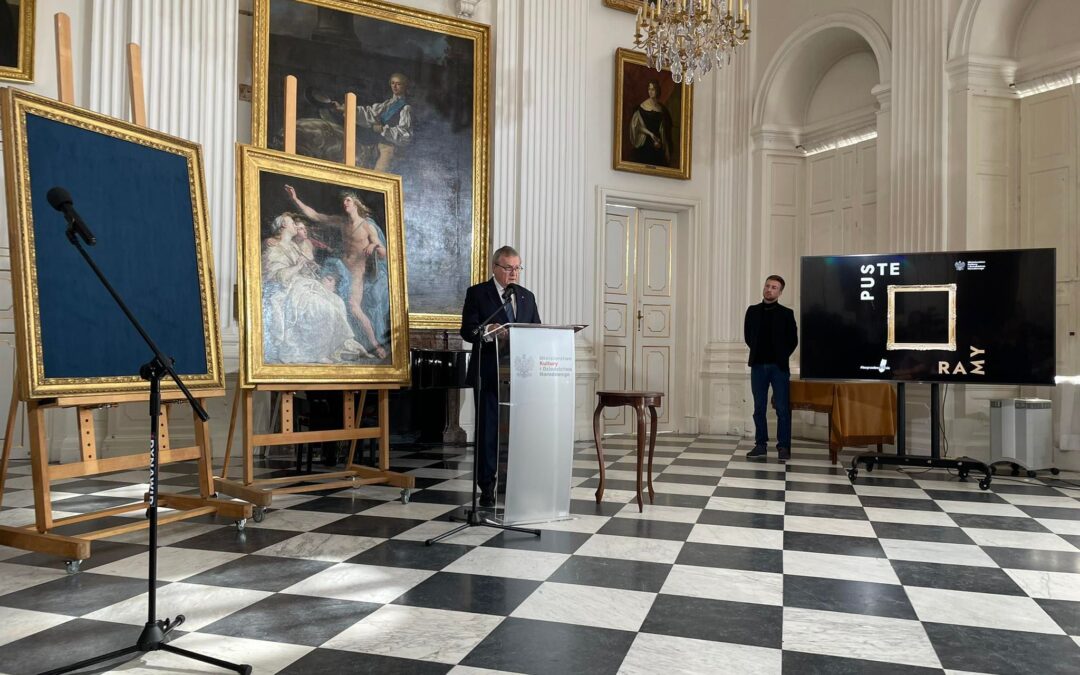The Polish government has launched a campaign to seek the return of hundreds of thousands of works of art and other cultural items that still remain missing after disappearing during the German and Soviet occupations in World War Two. It is focusing in particular on items now in Russia.
As well as losing around six million of its citizens during the war (17% of the population, a higher proportional death toll than any other country), Poland also saw much of its cultural heritage destroyed or stolen.
Launching the new “Empty Frames” campaign yesterday, culture minister Piotr Gliński noted that already by 1942 – in the middle of the war – it was estimated that around half the holdings of Polish museums had disappeared.
Postwar estimates indicated over 500,000 items had been stolen or damaged, with a combined value at the time of billions of dollars, says his ministry. A large proportion of those have never been recovered.
‼ Zainaugurowana dziś kampania #PusteRamy przypomina o dobrach kultury utraconych przez Polskę 🇵🇱 w czasie II wojny światowej.
Zachęcamy do zapoznania się z nową zakładką na stronie #MKiDN ⤵⤵⤵https://t.co/NrQYbyTCJA#bezprzedawNIEnia pic.twitter.com/CXce16kdNA
— Ministerstwo Kultury i Dziedzictwa Narodowego (@kultura_gov_pl) September 14, 2022
“To this day, in many Polish museums there are empty frames,” said Gliński. “Poland will never stop searching for and recovering cultural goods stolen during the war.”
While the current whereabouts of many plundered items remain unknown, the minister noted that Poland has also submitted 20 restitution claims to Russia for thousands of identified items. But the Russian government has not responded.
The items include works by Italian painters Luca Giordano, Spinello Aretino and Lorenzo di Credi that have been identified in the Pushkin State Museum of Fine Arts in Moscow, according to the ministry.
“Under international law, Russia is obliged to return Polish cultural goods stolen during the war,” noted Gliński. “Cases of the plunder of cultural goods do not expire – not only in the ethical and moral sense, but also in the sphere of international law.”
The Polish foreign ministry has pledged to work with the culture ministry to secure the return of stolen art. “We hope that Russia will finally get rid of the habits it has from Soviet times in terms of robbery and not giving back what was stolen,” said deputy foreign minister Piotr Wawrzyk, quoted by the Polish Press Agency (PAP).
As part of the “Empty Frames” campaign, Poland is planning to issue seven further restitution claims to Russia. Twelve museums from around Poland will also intensify efforts to raise awareness and seek the return of stolen items.
The Polish authorities have already had some success in securing the return of plundered items. Last year, a 16th-century icon was returned from Germany after being spotted in a museum by a culture ministry employee. This year, another 16th-century painting was returned from Sweden.
Recent weeks have seen the Polish government launch a renewed effort to seek restitution from Germany for losses caused to Poland during the Second World War, which Warsaw estimates to amount to $1.3 trillion.
On 1 September – the anniversary of Nazi Germany’s invasion of Poland in 1939 – the Polish ruling party unveiled a report on those losses and announced its intention to obtain compensation from Berlin.
Yesterday, parliament approved a resolution supporting those demands and also calling for a similar estimate to be made of losses caused by the Soviet occupation of Poland, which could then lead to a claim being made against Russia.
For more on Poland's demand for war reparations from Germany – and the legal issues involved – see our recent explainer by @MPiatkowski1 https://t.co/Y6Ss8AKGYL
— Notes from Poland 🇵🇱 (@notesfrompoland) September 14, 2022
Main image credit: MKiDN/Twitter

Daniel Tilles is editor-in-chief of Notes from Poland. He has written on Polish affairs for a wide range of publications, including Foreign Policy, POLITICO Europe, EUobserver and Dziennik Gazeta Prawna.




















